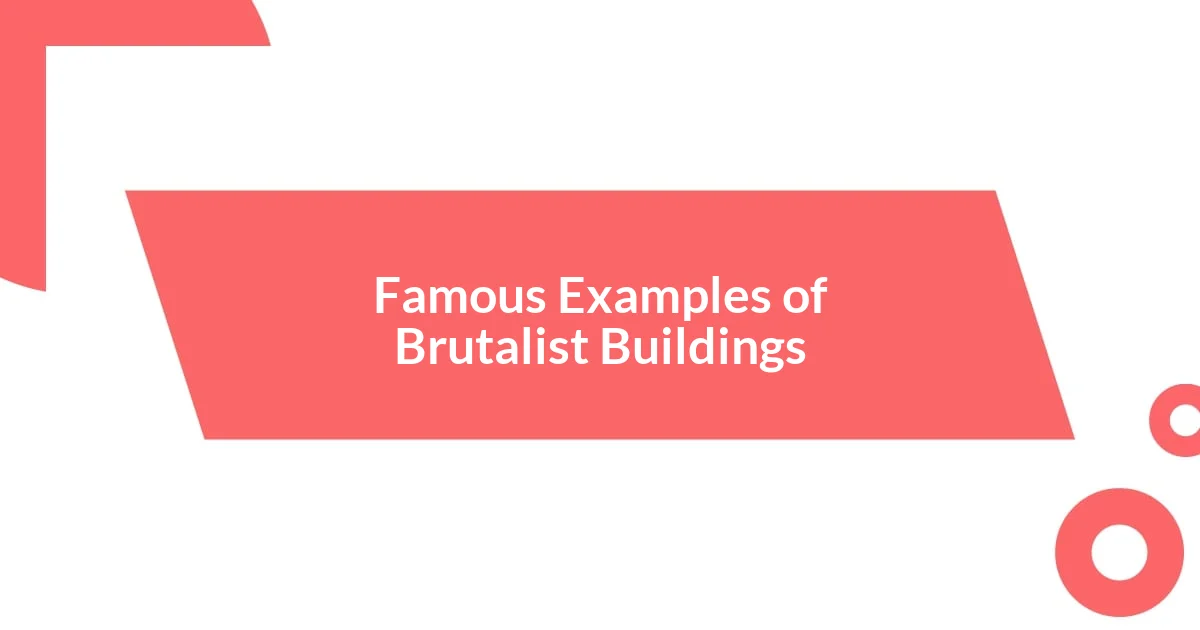Key takeaways:
- Brutalist architecture, characterized by raw concrete and massive forms, represents a reaction against ornate styles, emphasizing functionality and societal reflection.
- Famous examples include Boston City Hall, the National Theatre in London, and Habitat 67 in Montreal, each illustrating the style’s impact on urban identity and cultural expression.
- Brutalism generates polarized opinions, evoking both admiration for its boldness and criticism for its stark aesthetics, highlighting the complex relationship between architecture and society.

Overview of Brutalist Architecture
Brutalist architecture emerged in the mid-20th century, primarily characterized by its massive, block-like structures and raw concrete materials. I remember standing in front of a Brutalist building in college; the sheer weight of its presence almost felt oppressive yet oddly captivating. It provoked a question in my mind: how could something so stark and unadorned evoke such strong feelings?
Often seen as a reaction against the ornate styles that preceded it, Brutalism is all about functionality and honest expression of materials. It’s fascinating to think about how architects sought to represent social ideals through these rugged forms, often creating spaces with a utilitarian purpose. Have you ever felt inspired just by the boldness of a structure? I certainly have.
Brutalism can polarize opinions, with some viewing it as a necessary departure from traditional aesthetics while others see it as drab and unwelcoming. Personally, I find that its boldness can be a metaphor for resilience, embodying the spirit of a time when society was grappling with change. Don’t you think it’s intriguing how architecture can reflect the cultural climate of its era?

Key Characteristics of Brutalist Design
The essence of Brutalist design lies in its bold, uncompromising approach to architecture. When I first encountered a Brutalist library, the vast concrete walls felt like they were demanding my attention, almost challenging me to explore its brutal beauty. The stark functionality coupled with a sense of permanence can evoke a range of emotions, from admiration to discomfort.
Key characteristics of Brutalist design include:
- Raw Materials: Use of bare concrete or brick, emphasizing honesty in building materials.
- Massive Forms: Large, monolithic structures that often look imposing but can also feel monumental.
- Functional Aesthetic: Designs that prioritize utility over decoration, often showcasing the purpose of each space.
- Repetitive Patterns: Geometric shapes and forms that create a rhythm, contributing to the structure’s overall impact.
- Integration with Environment: Brutalist buildings frequently interact with their surroundings, accentuating both their scale and the landscape around them.
These traits reflect an architectural style that challenges conventional beauty, inviting us to engage with spaces in an entirely different way. Each building tells a story, a narrative woven into the very fabric of its design.

Famous Examples of Brutalist Buildings
One of the most iconic examples of Brutalist architecture is the Boston City Hall. I remember my first visit there; the building’s imposing, angular concrete facade felt like a fortress standing guard over the city’s governance. It sparked a sense of curiosity in me about how such a deliberately severe design could also represent civic pride and functionality.
Another notable structure is the National Theatre in London. The moment I stepped inside, I was enveloped by its raw concrete interiors, which evoke a sense of authenticity and artistry. It reminded me of the unfiltered creativity that thrives in spaces designed with purpose over aesthetic appeal. This theater is a brilliant example of how Brutalist architecture can provide a backdrop for cultural expression, transforming the ordinary into the extraordinary.
The Habitat 67 complex in Montreal is a personal favorite of mine. As I gazed at its stack of concrete forms resembling a miniature city, I felt a wave of inspiration about urban living. This piece of architecture isn’t just striking; it embodies an innovative approach to communal living, showcasing how Brutalism can transcend mere structural aesthetics and reflect social aspirations in a concrete canvas.
| Building | Location |
|---|---|
| Boston City Hall | Boston, USA |
| National Theatre | London, UK |
| Habitat 67 | Montreal, Canada |

Cultural Impact of Brutalist Architecture
Brutalist architecture has made a profound cultural impact, often polarizing opinions about its aesthetic value. Personally, I find that visiting these monumental structures is an experience that transcends mere observation—it’s an encounter with history and societal reflection. Have you ever stood before a massive concrete building and felt like it holds the weight of a community’s aspirations? That’s the powerful energy I’ve felt in places like the Barbican Centre in London, where the architecture itself feels like it’s narrating a story of resilience and ambition.
Interestingly, Brutalism often ignites conversations about urban identity and social equity. I remember discussing with friends how these stark buildings can serve as a canvas for community expression, embodying both the struggles and triumphs of the societies they inhabit. When you step inside the Boston City Hall, for example, it’s not just about the concrete; it’s about the meetings, protests, and decisions that have unfolded within those walls, reflecting the heartbeat of democracy.
Moreover, I’ve noticed that Brutalist buildings tend to evoke strong reactions, either love or disdain. Take the Trellick Tower in London; its unapologetic, towering silhouette often attracts criticism for being cold and uninviting. Yet, for me, there’s a certain beauty in its defiance—an emblem of modernist ideals that challenges us to reconsider the relationship between architecture and community. This duality, I believe, is what gives Brutalism its lasting cultural relevance, as it invites us into a complex dialogue about space and identity in our ever-evolving urban landscapes.

Criticism and Controversies
While Brutalist architecture has its passionate advocates, it also faces significant criticism for its often stark aesthetics. I recall discussing this with a colleague who described concrete monoliths like the Boston City Hall as “the architectural equivalent of a cold shower.” This analogy hits home—the chill from the design can feel unwelcoming. Why do so many people react so intensely against these structures? Perhaps it’s because they evoke feelings of alienation rather than warmth.
Another layer of controversy tends to revolve around the social implications of Brutalism. In my experience visiting these buildings, I’ve come to appreciate them not just for their visual appeal but for the societal commentary they often carry. Yet, I remember chatting with a friend who argued that they can also represent government oppression, reinforcing a disconnect between the institutions housed within and the public they serve. Isn’t it fascinating how a building can simultaneously symbolize strength and become a metaphor for bureaucracy?
Moreover, the maintenance of Brutalist structures sparks debate as well. The wear and tear on concrete can diminish their impact, leading some to label them as “eyesores.” There’s a bittersweet nostalgia when I see a neglected Brutalist building; it evokes the question: How do we balance preservation with the evolving needs of our cities? I believe it’s crucial to recognize that these structures embody a historical moment—if only we could discover a way to revitalize their significance without losing their essence.

Tips for Appreciating Brutalist Style
To truly appreciate Brutalist architecture, I recommend taking a moment to engage with the materials. When I first examined the raw concrete of the National Theatre in London, I found myself tracing the grooves and imperfections with my fingers, almost as if I was connecting with the very essence of its creation. Isn’t it intriguing how these textures can evoke a sense of authenticity and human craftsmanship?
Another enriching experience is to view these structures at different times of the day. I remember visiting the Barbican once during the soft light of sunrise; the subtle shadows it cast transformed the imposing concrete into something almost gentle. Have you noticed how the changing light can breathe life into a building? This dynamic quality is often overlooked, revealing the architecture in a new light—literally.
Lastly, immerse yourself in the narratives surrounding these buildings. I recall attending a local tour where a passionate guide shared stories about the community’s relationship with a Brutalist housing block. Listening to how the residents fought to preserve their homes instilled a deeper sense of connection within me. It made me realize that Brutalism is not just about cold concrete; it’s about the lives that unfold within and around it. How fascinating it is to think of each structure as a repository of human experience!















